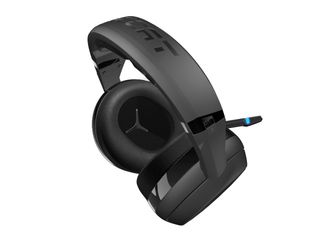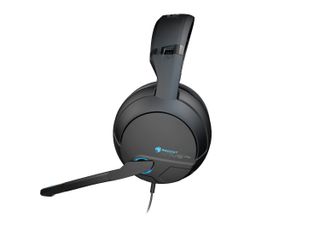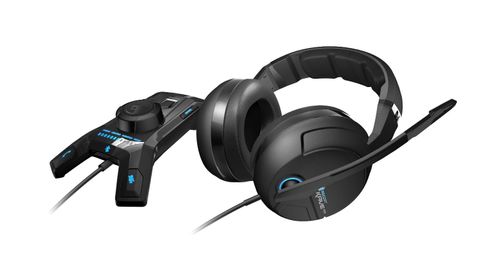TechRadar Verdict
The Roccat Kave XTD offers excellent performance, plenty of features and a comfy design, but isn't all that portable. These cans are for desktop PC gamers only.
Pros
- +
Quite light and comfy
- +
Has its own soundcard
- +
Plenty of features
Cons
- -
USB interface only
- -
Not very portable
- -
Spotty app compatibility
Why you can trust TechRadar
Sound cards in gaming PCs, save for serious audiophiles, have largely been rendered irrelevant by motherboards with more than passable sound chips. Ailing bassheads could just try and cram a sound card into their gaming rigs, but German peripheral peddler Roccat has another idea. This is the Kave XTD gaming headset, with 5.1 digital surround sound and its very own sound card enabling a swath of fun features.
For those who follow Roccat, the Kave XTD is the successor to the company's $129 Kave 5.1. The difference here is a.) the price: $169 (about £101, AU$188), b.) its sedentary design and c.) it's feature set.
Where the original Kave 5.1 was focused on a fusion of portability and features, the XTD is all about offering as many relevant features as possible in a similar package, committing to a desktop-first design. However, that comes with some compromises that might not fly for more mobile-minded gamers.

Design
Save for the original's folding ear cups (these tilt for a better fit), the XTD looks nearly identical to the the Kave 5.1 in shape and silhouette. You'll get the same thick, black leatherette cushions for your ears, which are comfy if a tad stiff. The headband is now a single – but indented – strip of cushioned fabric where the Kave 5.1 sported three separate fabric cushions.
On the outside, the XTD rocks the same soft touch plastic on the cans and plenty of glossy plastic accents on the headband and microphone. The band extends eight notches, but also has half-extensions on each number for fine control over its fit. This is extremely important, as the ear cup cushions are more rigid than I'd like. (You might still get that pressurized feeling while and after wearing the XTD, though I'm quite sensitive to it.)
What's interesting is that the microphone is removable, though I'm not sure why, given that the XTD is not all that portable. You see, this headset is not only wired, but permanently tethered to the USB desktop remote. This is a must, given the device's onboard sound card, I'm told.
Speaking of which, the included – whether you like it or not – USB remote is a major shift in design from the previous model. Coated in shiny black plastic, this dock, if you will, stands on two prongs with soft touch buttons to mute the microphone and accept phone calls. (More on that later.) Pressing any of these buttons activates cool blue LEDs underneath, and muting the mic causes a similar light to glow on the mouthpiece.

Front and center is a large rubber and plastic knob that controls volume with a corresponding row of blue lights underneath. Touching the capacitive Bluetooth button causes the XTD to broadcast its signal to nearby smartphones and the like. All of these features are possible through USB and only USB, which, if you ask me, is a bit of a bummer.
The XTD offers audio ports for whatever 5.1 speaker setup you might have, making this unit your receiver, in a way. The "Speakers" button feeds the audio coming through via USB to the speakers, allowing you to control the volume and channels from the desktop remote.
However, this means one less USB slot for you, which can be problematic for gaming laptops or smaller case setups. Not to mention this limits the XTD's compatibility to Windows-based systems – no jacking into your Xbox One or Sony PS4 with this thing. I'm told that a $99, 3.5mm jack model is in the works, but will lack the integrated sound card. The wise words of Mick Jagger: You can't always get want you want.
Sound quality
Before we get into this, I must admit that I'm not exactly an audio nut. The nuanced differences between lossless sound and 320 kbps audio don't come to me naturally. That said, I was impressed by both the volume and depth that the XTD provided.

Listening to Phantogram's latest hit "Fall in Love," I could hear the reverberations in the lowest-of-fi bass chords on the synthesizer. During some intense sessions in the recent Titanfall beta test, I could hear rockets whiz by the left and right sides – and yes, I could tell which – of my giant suit of mecha armor.
But Roccat promises that the XTD's built-in sound card (and three drivers per ear cup) allows for more subtle effects, like hearing the direction from which enemy footsteps are coming. My kill-death ratios are evidence enough that I couldn't hear opponents' boots in Titanfall, even when inside buildings. Though, that could be due to the bombastic nature of the game.
What I did love about this headset is how could boost its performance, down to the audio sampling in kilohertz (up to 48KHz). You can also up the virtual bass, which noticeably boosts depth, and enhance the quality of compressed audio.

That latter feature was so amazing for streaming music over Spotify that I wonder why it wasn't toggled by default. This is all possible through Roccat's software, lazily named "Roccat Kave XTD Sound Console," which you can download from its website. Given that it's a USB device with a sound card, I would expect this software to come pre-loaded on the unit, but alas. Regardless, you'll definitely want to download this app.
Fun, useful features
Through Roccat's feature-rich software, not only can you mix stereo sound to come through the headset's 5.1 channels, but you can automatically normalize the volume across apps and media. The mixing solution isn't the greatest, given that its applying audio that wasn't recorded in 5.1 to those channels, but it makes a difference for sure.
What's more interesting are features like Xear Magic Voice, which transforms your voice into either that of a monster, man, woman or a rubber duck. I used this feature to great effect when calling a colleague, though she didn't like hearing me as a rubber duck all that much. That said, it's fantastic for pranking friends and coworkers or remaining anonymous during public game sessions.

Interesting as voice masking is, the most important feature on offer here is probably Bluetooth support for smartphones. Similar to most Bluetooth headsets, the XTD can take calls from your smartphone, minimizing distraction during those tense firefights. Pressing the phone button on the desktop remote answers an incoming call and automatically reduces the PC volume.
Verdict
The Roccat Kave XTD presents quite a deal for PC gamers, saving them much-needed chassis space with its own sound card. That said, the XTD is in no way ideal for portable use, nor is it compatible with any platform but Windows. Wireless headsets, like Sony's PlayStation Gold Wireless Stereo, offer cross-platform compatibility and 5.1 sound (on PlayStation at least) for just $100.
Also, I must admit that setup with certain apps, especially Steam's voice chat, proved troublesome, with the program recognizing either audio input or output, and never both simultaneously. A simpler 3.5mm interface would fix these issues, but wouldn't be able to support this robust feature set.
The dedicated, DIY type of PC gamer – the kind with their own gaming desk or den – will find a lot to like in the Kave XTD. This is a comfortable headset with great performance and upscaling/sampling features only possible with a sound card. While you won't be able to take it elsewhere, this headset could be the final set piece for your shrine to PC gaming.
Joe Osborne is the Senior Technology Editor at Insider Inc. His role is to leads the technology coverage team for the Business Insider Shopping team, facilitating expert reviews, comprehensive buying guides, snap deals news and more. Previously, Joe was TechRadar's US computing editor, leading reviews of everything from gaming PCs to internal components and accessories. In his spare time, Joe is a renowned Dungeons and Dragons dungeon master – and arguably the nicest man in tech.


